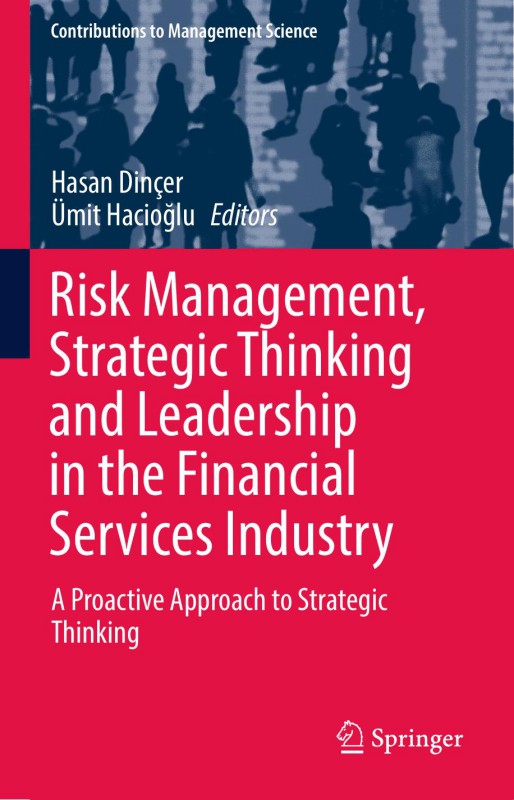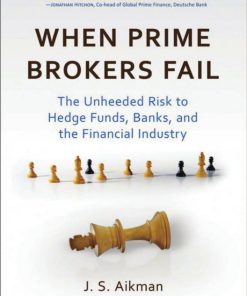Risk Management Strategic Thinking And Leadership in the Financial Services Industry A Proactive Approach to Strategic Thinking 1st Edition by Hasan Dinçer, Ümit Hacioğlu 3319471716 9783319471716
$50.00 Original price was: $50.00.$25.00Current price is: $25.00.
Authors:Hasan Dinçer , Series:Strategic Studies [7] , Author sort:Dinçer, Hasan , Languages:Languages:eng , Published:Published:Dec 2016 , Publisher:Springer
Risk Management Strategic Thinking And Leadership in the Financial Services Industry A Proactive Approach to Strategic Thinking 1st Edition by Hasan Dinçer, Ümit Hacioğlu – Ebook PDF Instant Download/Delivery. 3319471716, 9783319471716
Full download Risk Management Strategic Thinking And Leadership in the Financial Services Industry A Proactive Approach to Strategic Thinking 1st Edition after payment

Product details:
ISBN 10: 3319471716
ISBN 13: 9783319471716
Author: Hasan Dinçer, Ümit Hacioğlu
This book presents a broad overview of risk management in the banking industry, with a special focus on strategic thinking and decision-making. It reveals the broader context behind decision models and approaches to risk management in the financial industry, linking the regulatory landscape for capital management and risk to strategic thinking, together with behavioral and cultural assessments.
Risk Management Strategic Thinking And Leadership in the Financial Services Industry A Proactive Approach to Strategic Thinking 1st Table of contents:
Part I: Economic Outlook and Expectations for the Financial Services Industry
Global Economic Outlook
1 Introduction
2 Literature Review
2.1 Global Outlook
2.2 Global Outlook of Developed Economies: USA, Japan, Euro Zone
2.3 Global Outlook of Emerging National Economies: Brazil, Russia, India, China and South Africa
3 Conclusion
References
Sustainable and Inclusive Finance in Turkey
1 Introduction
2 Review of Literature
3 Inclusive Finance in Developing Countries
3.1 Inclusive Finance in Turkey
4 Conclusion
References
Monetary Policy Divergence and Central Banking in the New Era
1 Introduction
1.1 The World Economy: A New Normal?
1.2 The Inflation Outlook
2 Policy Implementation
2.1 Policy Options
2.2 Monetary Policy Divergence
2.2.1 Tightening Countries Such as the US and the UK
2.2.2 Expanding Countries
2.2.3 Implications for the EMs
3 Central Banking in the New Era
4 Concluding Remarks
References
In Looking into the Foreign Exchange Risk Management
1 Introduction
2 The Financial Risks of International Trade and Investment
2.1 Economic Risk
2.2 Transaction Risk
2.3 Translation Risk
3 Measuring Economic, Transaction and Translation Exposure
3.1 Measuring Economic Exposure
3.2 Measuring Transaction Exposure
3.3 Measuring Translation Exposure
4 Hedging Foreign Exchange Risk: The Details of Risk Management
4.1 Invoice Currency
4.2 Matching
4.3 Netting
4.4 Leading and Lagging
4.5 Forward Contract
4.6 Options
4.7 Swaps
4.8 Currency Futures
5 Risk in Foreign Currency Borrowing: Indian Perspective
6 Conclusion
References
The Link Between Dollarization and Its Determinants in Turkey
1 Introduction
2 Studies on Dollarization: A Literature Overview
3 Data and Methodology
4 Empirical Findings
4.1 Geweke (1982) Measure of Linear Feedback
4.2 Frequency Domain Granger Causality
4.3 Comovement Analysis
5 Conclusion
References
Enhancing the Risk Management Functions in Banking: Capital Allocation and Banking Regulations
1 Introduction
2 The Role of Capital; Key Banking Risks
3 Regulatory Capital Versus Economic Capital in Banking
4 Banking Regulations on Capital Requirement
4.1 Basel I
4.2 Basel II
4.3 Basel III
5 Literature Review on Economic Impact of Capital Requirements
6 Conclusion
References
Part II: Managing Risks in Capital Markets
The Calibration of Market Risk Measures During Period of Economic Downturn: Market Risks and Measure
1 Introduction
2 Methodology
2.1 The Generalised Extreme Value Distribution
2.2 Generalised Pareto Distribution
2.3 Definition of Copula Distribution
2.4 Estimation of Copula Parameters
2.5 Sklar´s Theorem
3 Empirical Analysis
4 Conclusion
References
Computation of Operational Value at Risk Using the Severity Distribution Model Based on Bayesian Met
1 Introduction
2 Basic Indicator Approach
3 Standardised Approach
4 Pitfalls of the Basic Indicator and Standardised Approaches
5 The Advanced Measurement Approach
6 Using the Convolution Technique to Build the Total Annual Loss Distribution
7 Modelling Loss Frequency and Severity Distributions
7.1 Loss Frequency Distribution
7.2 Loss Severity Distribution
8 Estimation of the Loss Distribution´s Parameters
9 Bayesian Method
9.1 Bayesian Estimation of the Loss Frequency: Poisson Distribution
9.2 Bayesian Estimation of Loss Severity: The Body part with Lognormal Distribution
9.3 Bayesian Estimation of the Loss Severity: The Tail Part with the Generalised Pareto Distribution
9.4 Simulating the Posterior Distribution: The Gibbs Sampler
10 The Overall Annual Loss Distribution Using Copula Function
10.1 Sklar (1959) Theorem
11 Empirical Analysis with Simulated Data
12 Conclusion
References
Liquidity Risk and Optimal Redemption Policies for Illiquid Investments
1 Introduction
2 Optimal Redemption Policies for Hedge Fund Investments
3 Setting and Notation
4 Dynamic Programming Setup
5 Structure of the Optimal Redemption Policy
6 Monotonicity of the Critical Values
7 Conclusion and Future Research
References
Credit Derivatives, Their Risks and Role in Global Financial Crisis
1 Introduction
2 Types of Credit Derivatives
2.1 Credit Default Swaps
2.2 Total Return Swaps
2.3 Credit-Linked Notes (CLN)
2.4 Credit Spread Options
2.5 Collateralized Debt Obligations (CDOs)
3 Size of Credit Derivatives Market
4 Risks Associated With Credit Derivatives
4.1 Credit Risk
4.2 Counterparty Risk
4.3 Systemic Risk
4.4 Transaction Risk
4.5 Liquidity Risk
5 Credit Derivatives and Their Role in Global Financial Crisis
6 Conclusion
References
An Approach to Measure Financial Risk Relative Indices: A Case Study of Indonesian Insurance Compani
1 Introduction
2 Data and Methodology
3 Descriptive Statistic and Calculation of Relative Risk Indices by CFA
4 Conclusion
References
Part III: Volatility, Hedging and Strategy in Risky Environment
Extreme Value Theory in Finance: A Way to Forecast Unexpected Circumstances
1 Introduction
2 Theoretical Background of EVT
2.1 Generalized Extreme Value (GEV) Distribution
2.2 Block Maxima Method
2.3 rth Largest Order Models
2.4 The Peaks-Over-Threshold Method
3 EVT in Finance
3.1 Financial Stress Tests with Copula
3.2 Utilizing EVT for Crisis/Stress Event Classification
4 Conclusion
References
Value at Risk Performance of Emerging Market Equity Portfolios During the Fed´s Tapering
1 Introduction
2 The Impact of Fed´s Tapering Announcements on Emerging Market Economies
3 Literature Review
4 Methodology
4.1 Variance Covariance VaR
4.2 Historical Simulations
4.3 Back Testing
5 Data of the Equity Portfolios and Results
6 Data of Equally Weighted Emerging Equity-US Bond Portfolios and Results
7 Discussion
8 Conclusion
References
Jumps and Earnings Announcement: Empirical Evidence fromAn Emerging Market Using High Frequency Data
1 Introduction
2 Summary of Literature
3 Methodology
3.1 Data
3.2 Jump Detection Procedure
3.3 Estimation of Abnormal Returns
4 Empirical Findings
5 Conclusion
References
Hedging Scenarios Under Competition: Exploring the Impact of Competitors´ Hedging Practices
1 Introduction
2 Literature Review
2.1 Hedging and Risk Management
2.2 Game Theoretic Dynamic Models
3 Definitions and the Model
3.1 The Parameters and Actions
3.2 The Single Period Model
4 Simulations
4.1 Experiment Setup
4.2 Simulation Results
4.3 Interpretation of Simulation Results
5 Conclusion
References
Option Strategies and Exotic Options: Tools for Hedging or Source of Financial Instability?
1 Introduction
2 Option Contracts
2.1 Option Types
2.1.1 Call Options
2.1.2 Put Options
2.1.3 Maximum Profit and Loss for the Parties in Option Contracts
2.2 Option Pricing Models
2.2.1 Binomial Model
2.2.2 Black-Scholes Model
2.3 Greeks
2.3.1 Delta
2.3.2 Theta
2.3.3 Gamma
2.3.4 Rho
2.3.5 Vega
3 Option Strategies
3.1 Strategies with Ownership of Underlying Securities
3.1.1 Covered Call
3.1.2 Protective Put
3.2 Bullish Strategies
3.2.1 Bull Call Spread
3.3 Bearish Strategies
3.3.1 Bear Call Spread
3.4 Strategies in Untrendy Markets
3.4.1 Butterfly Spreads
3.5 Strategies in Trendy Markets
3.5.1 Straddle
3.5.2 Strangle
4 Exotic Options
4.1 Look Back Options
4.2 Barrier Options
5 Conclusion
References
Part IV: Risk-Based Audit and the Structured Finance
Risk Based Internal Audit
1 Introduction
2 Audit Types
2.1 Audit Types by Purpose
2.1.1 Audit of Financial Statements
2.1.2 Compliance Audit
2.1.3 Operational Audit
2.2 Audit Types by Scope
2.2.1 Mandatory Audit
2.2.2 Arbitrary Audit
2.2.3 Permanent Audit
2.2.4 Limited Audit
2.2.5 Special Audit
2.3 Types of Audit by Status
2.3.1 External Audit
2.3.2 Internal Audit
2.3.3 Public Audit
3 Internal Audit Concept
3.1 Types of Internal Audit
3.2 Benefits of Internal Audit
4 Risk and Risk Management
4.1 Uncertainty and Risk
4.2 Types of Risk
4.3 Corporate Risk Management
5 Risk Based Internal Audit
5.1 Definition and Scope of Risk-Based Internal Audit
5.2 Comparison of Traditional Internal Audit and Risk-Based Internal Audit
5.3 Risk Assessment and Recording of the Risks
5.3.1 Qualitative Analysis
5.3.2 Quantitative Analysis
5.3.3 Possibility-Effect Analysis
5.3.4 Risk Matrix
6 Conclusion
References
Recent Financial Crisis and the Structured Finance: Accounting Perspective for Future
1 Introduction: Overview of Structuring
2 Triggers of Financial Shock
3 The Rationale of Default Correlation and Systematic Risk
4 Accounting Perspective: M2M or Historical Cost?
5 Conclusion
References
Compliance and Reporting Trends: Essential Strategies
1 Introduction
2 Background
3 Literature Review
4 Conclusion
References
Developing a Risk Management Framework and Risk Assessment for Non-profit Organizations: A Case Stud
1 Introduction
2 Literature Review
3 Risk Management for NPOs
4 Case Studies
4.1 Risk Identification
4.2 Risk Quantification
4.3 Risk Evaluation
4.4 Risk Mitigation
5 Conclusions
References
Part V: Culture and Leadership in Risk Management
Giving Risk Management Culture a Role in Strategic Planning
1 Introduction
2 Global Financial Institutions and Risk Management
3 Risk Management Culture
4 The Role of Risk Management Culture in Strategic Planning
5 Conclusion
References
Agile Intrapreneurship in Volatile Business Environment: Changing Roles of Financial Managers and Ri
1 Introduction
2 Schumpeterian Innovation and Endogenous Growth
2.1 The Relation Between Innovation and Investment
2.2 From Labourer to Schumpeterian Entrepreneur
2.3 Neo-Schumpeterian Approach
2.4 Endogenous Growth Approach and Human Capital
3 Intrapreneurship from the Perspective of the Contemporary Management and Organization Approach
3.1 Organizational Intrapreneurship
3.2 Lean Management and Lean Startup
3.3 Strategic and Agile Management
4 Changing Roles of Managers in Organizations
4.1 Differences Between Leaders and Managers
4.2 Current Leadership Styles
4.3 Expanding Roles of Financial Risk Takers and Chief Financial Officers
5 Conclusion
References
Emerging Trends in the Post-Regulatory Environment: The Importance of Instilling Trust
1 Introduction
2 Background
3 Literature Review
4 Conclusion
References
The Effect of National Culture on Corporate Financial Decisions
1 Introduction
2 The Role of Culture/National Culture in Corporate Decision Making
3 Hofstede´s Dimensions of National Culture and Financial Decision-Making
4 Methodology and Data
5 Results
6 Conclusion
Appendix
References
Human Side of Strategic Alliances, Cooperations and Manoeuvrings During Recession and Crisis
1 Introduction
2 Effects of Crises on Organizations and Employees
3 Human Factor in Crisis Management
3.1 Developing Resistance Against Crisis
3.2 The Role of Employees in Strategic Crisis Planning
3.3 Effectiveness of Organizational Communication in Recession and Re-organization
4 Capacities and Strategic Manoeuvres that Provide Adaptation to Sudden Changes by Organizational Le
4.1 Reactions of Employees During Re-Organization Process
4.2 From Classical Management to Lean Organizations for Adaptation to Sudden Changes
4.3 The Behaviours of Employees During the Stages of Strategic Alliances, Merger and Acquisition Pro
5 Conclusion
People also search for Risk Management Strategic Thinking And Leadership in the Financial Services Industry A Proactive Approach to Strategic Thinking 1st:
risk management strategic plan
risk management leadership skills
leadership skills for strategic risk management
risk management leadership












